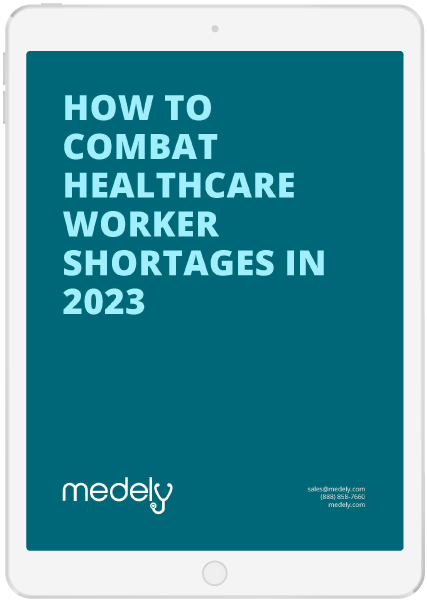Strategies to Keep Up With the Changes at Your Skilled Nursing Facility
Staffing shortages have been a major concern across the healthcare industry, especially with the new nursing home staffing standards set by the federal government on April 22, 2024 which sets new staffing standards at these facilities. For close to a decade, experts have predicted a nursing shortage as many nurses reach retirement age. Plus, many nurses and other healthcare workers have left the profession during and after the pandemic due to stress, exhaustion, and burnout.
Skilled nursing facilities continue to face significant nursing shortages. Understanding why nurses leave residential facility jobs and what would entice them to stay can help managers attract and retain highly skilled staff in this challenging environment.
Responding to the New Nursing Home Staffing Standards
The demand for post-acute care facilities is rapidly growing as a large population, particularly Baby Boomers and Gen X start to progress into their older years. This demand for care is increasing much faster than the number of registered nurses available to help provide said care, causing additional stress at assisted living facilities. Understanding why nurses leave residential facility jobs and what would entice them to stay can help managers attract and retain highly skilled staff in this challenging environment. Skilled nursing facilities continue to face significant nursing shortages, and strategies must be implemented to overcome these challenges.
The Biden administration finalized nursing home staffing standards on April 22, 2024, marking the most substantial changes to federal oversight of nursing homes in over three decades. These regulations aim to address long standing staffing shortages, which have been identified as a contributing factor to various quality-of-care issues such as missed diagnoses, bedsores, and falls, especially exacerbated during the COVID-19 pandemic. Under the new mandates, nursing homes will be required to increase their staffing levels, particularly for registered nurses (RNs), licensed practical nurses (LPNs), and certified nursing assistants (CNAs). This necessitates a strategic overhaul of staffing models within assisted living facilities to meet the minimum requirements outlined by CMS.
Efforts to attract and retain staff, including flexible scheduling, social media recruitment, and improved compensation packages, are essential to address these challenges.
Staffing Concerns in Skilled Nursing Facilities
Skilled nursing facilities rely on qualified staff to provide the specialized care their patients need. Historically, these facilities have employed only a fraction of the nursing workforce. According to data from the Bureau of Labor Statistics, only 6% of U.S. nurses choose to work in a skilled nursing facility environment. With demand for residential care increasing as the Baby Boomer generation ages, there is a growing need for reliable, highly qualified nursing staff.
Unfortunately, hiring and retaining nurses has been a challenge. According to recent Health Affairs data, the staff turnover rate was 94%. The COVID-19 pandemic compounded the challenge as residential healthcare facilities struggled with outbreaks. Between 2020 and 2022, the nursing home sector lost 15% of its staff.
Post-pandemic recovery has been slow for skilled nursing facilities. According to the American Healthcare Association, as of 2022, 87% of nursing homes experienced moderate or high staffing shortages, and 98% of nursing homes have had difficulty hiring new staff.
Why Nurses Leave Their Jobs
In recent surveys of skilled nursing facility staff, nurses cite a variety of reasons for leaving skilled nursing facilities, including:
- Burnout
- Lack of respect
- Poor pay and benefits
- Lack of career advancement opportunities
- Opportunities for better-paying employment elsewhere
- Unsafe working conditions and workloads
Burnout is one of the main reasons nurses leave their jobs, and the workplace environment can contribute to the problem. Frequent turnover, insufficient shift personnel, and increased workloads can exacerbate staff dissatisfaction and burnout. Nurses who feel overworked and underappreciated may resign due to overly stressful working conditions.
Strategies to Attract and Retain Staff
Skilled nursing facility managers must think comprehensively about solutions to healthcare staffing shortages in reaction to the new nursing home staffing standards. Both recruiting strategies and changes to workplace policies can improve hiring and staff retention.
Flexibility in Staffing Schedules: Work-life balance is important for people in any profession. Nurses who experience tremendous responsibility and pressure on the job need adequate time to relax and care for themselves and their families. Creating scheduling systems that offer staff flexibility can improve morale. Facilities can offer non-traditional shift start and end times, commute-friendly shift times, and scheduling policies that allow nursing staff to make schedule adjustments without penalty.
Skilled nursing facilities can use Medely to help them with scheduling contingent staff, time-tracking, billing, and credentialing, all in one platform. Learn more here.
Use Social Media to Attract Applicants: Advertising open positions on local social media groups and pages and highlighting team members, showing how much you appreciate them, can increase your reach among qualified applicants living near your facility. Social media posts can attract comments from current or former employees who can share their positive experiences, which may encourage more applications.
Offer Incentives: Financial compensation is a tried-and-true method of attracting and retaining staff. Some facilities have introduced programs such as offering bonuses for new employees who stay through a trial period. Others have offered referral incentives, where employees who refer a new employee receive a bonus.
Improve Compensation Packages: One consistent issue with nursing home staffing is that wages are lower than in other parts of the healthcare industry. This is, in part, driven by Medicare and Medicaid reimbursement rates, which keep overall facility budgets tight. When possible, nursing homes can raise wages to attract staff. In addition, expanding employee benefits to include perks like 401(k) plans and tuition reimbursement programs can improve hiring. Conversely, some staff may prefer a higher hourly pay rate and forego benefits like health insurance. A menu of compensation packages can attract more interested applicants.
Employee Appreciation Programs: Creating a supportive, welcoming work environment can improve staff morale. Improvements to work culture, such as offering free meals to staff, bringing in massage therapists or yoga instructors for occasional treats, and other activities to foster a sense of community. These activities may increase the staff’s sense that the workplace is committed to their happiness and well-being. Prioritizing flexibility to address personal issues such as car trouble or a sick child can help improve work-life balance.
Information sharing: In addition to frequently training new staff, many facilities rely on contract staff to fully staff shifts. Creating accessible patient profiles can ensure that new staff understand patient needs quickly. This improves patient care while reducing the time veteran staff need to brief new staff. A report from the Department of Health and Human Services detailed how one facility created individualized, one-page care guides for each resident. Another facility posted icons indicating information such as fall risk or hearing impairment outside each resident’s door so staff could see pertinent information as they entered the room.
Adjust Workflows: Facilities can streamline workflows by adopting new technologies and staffing models that assist in keeping your facility up to date with the new federal nursing home standards. Nursing facility management software that combines electronic health records (EHR), electronic medication administration records (EMAR), and digital patient profiles can centralize recording keeping and simplify communication between staff. Some software systems are compatible with mobile devices and may support voice-to-text reporting. In addition, facilities can rethink staff assignments during shifts. Adding so-called floating staff to lend a hand as needed can reduce pressure on other personnel.
Manage your internal resource pool and your entire extended workforce with Medely. Check out our website for more information about how we work specifically with post-acute care facilities like skilled nursing facilities, nursing homes, and more.
Partner with Nursing Schools: Some residential facilities have formed beneficial partnerships with nursing schools, community colleges, and other healthcare training programs. Offering students opportunities to do practical hours at the facility can spark interest in continuing to work there after graduation. In addition, facilities can offer tuition assistance to staff who want to get continuing education at local institutions.
Bring in per diem staff: To address staffing gaps and the new nursing home staffing standards, managers can work with staffing solutions like Medely to bring in additional per diem nurses and allied health professionals. Medely is a comprehensive staffing solution that provides instant access to a flexible, vetted, background-checked pool of nurses and health professionals.
Medely offers a highly skilled pool of nurses and allied professionals with experience in skilled nursing facilities, hospitals, post-acute care facilities, and surgery centers. Contract staff are available for both per diem and longer assignments. All of Medely’s professionals have vetted credentials for the assignments they take. Our easy-to-use booking platform allows access to professional information, timesheets, and billing in one place.
To learn more about how Medely can help you build and manage your entire workforce and address staffing shortages, contact us or set up your free account and get started immediately.

How to effectively combat healthcare labor shortages in 2024
Learn how to effectively combat healthcare labor shortages with an extended workforce to maintain continuity of care and gain access to tools you can use to manage your extended workforce more effectively and efficiently. In this eBook, you’ll learn:
- ■ Why nurses are leaving full-time jobs behind.
- ■ The factors impacting healthcare professional employment.
- ■ How you can use an extended workforce to meet demand.
- ■ How you can use data-led staffing planning to manage costs.



